Sustainable IT focuses on reducing the environmental impact of your technology landscape. Embracing sustainability in IT benefits both the environment and the financial performance of companies that adopt it.
RiverbedUnified Observability portfolio is ready to tackle the energy efficiency and sustainability demands of modern businesses. With its focus on Sustainable IT, the Riverbed portfolio aims to support energy-conscious practices and meet the energy reporting requirements worldwide.
Sustainability consciousness is on the rise
In an era of heightened environmental consciousness, corporations face increasing pressure to decrease their carbon footprint and adhere to sustainability regulations like the European Green Deal and the international Greenhouse Gas (GHG) Protocol.
In early September 2023, the state of California introduced landmark legislation, SB 253, which mandates environmentally conscious disclosure obligations for thousands of U.S. public and private companies. The EU had already announced similar requirements as part of their CSR Directive in early January 2023.
With growing adoption of these disclosure laws worldwide, Riverbed Aternity’s Sustainable IT dashboards have been developed with flexible configuration and customization to be adaptable to local needs. Watch this video to see how Aternity provides your IT teams with the full suite of tools to tackle Sustainable IT requirements and practices:
How Riverbed Aternity’s energy efficiency solution helps
Aternity equips your IT teams with a comprehensive suite of tools to address Sustainable IT requirements and best practices. This includes out-of-the-box dashboards that compile essential energy data, automation workflows, built-in surveys, and notifications for end-users.
Riverbed Aternity has introduced a new “Sustainability” category of dashboards, with regular additions of new “Sustainability” dashboards as they become available.
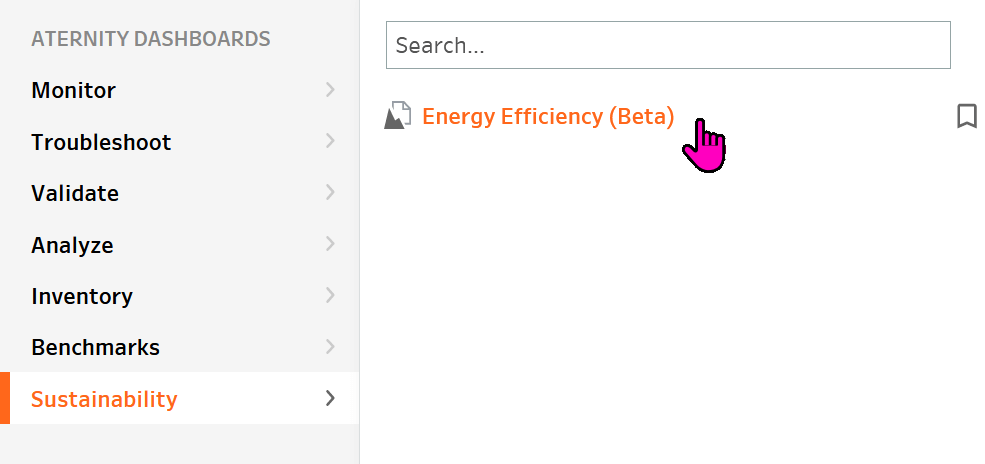
Now, let’s explore an example “Energy Efficiency” dashboard of a company with a global workforce, including remote employees. This dashboard vividly illustrates how seemingly innocuous power settings on Windows laptops can significantly impact power consumption across the board. It also provides a clear understanding of the nuanced details of the energy demands of user equipment.
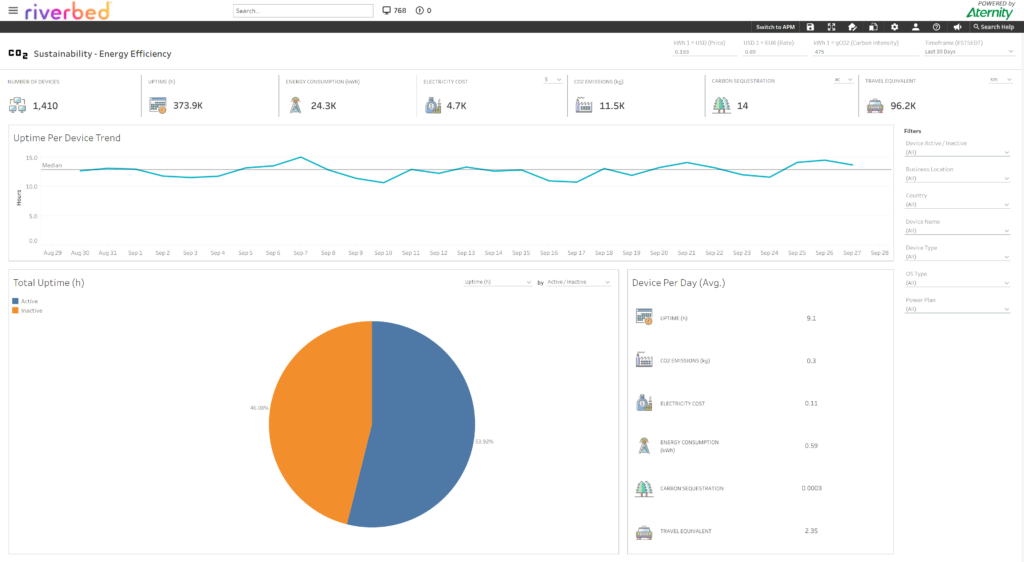
Looking at all the user devices in this company collectively, it’s apparent that around 46% of the time in a month, the devices consume power despite users not actively interacting with them. Aternity refers to this time as “Inactive.”
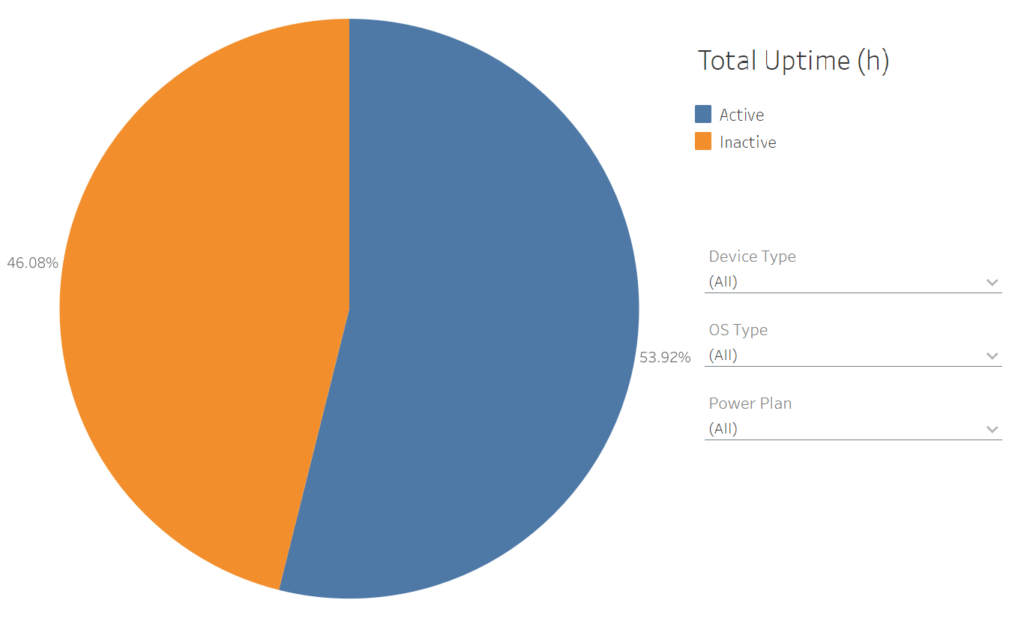
Let’s delve into how this 46% “Inactive” time was calculated:
An hour of uptime is considered “Inactive” when no keystrokes or mouse movements are detected by Aternity, and the screen or monitor is either in sleep mode or locked while consuming full power. However, if there is any keyboard or mouse activity, that hour counts as “Active.” As the calculation of idle time is very conservative, there could easily be a lot more power wastage occurring. In some tools, the “Inactive” time is also called “Idle Time.”
Optimize energy conservation with Balanced Power Plan
Looking into the details of Windows devices, especially those using the “Balanced Power Plan,” a Windows out-of-the-box setting for reducing power consumption, it’s evident that collectively, almost 53% of the time, these devices remain idle while still consuming power. In fact, the percentage of time these devices were “Inactive” is even higher for devices using the “Balanced Power Plan.”
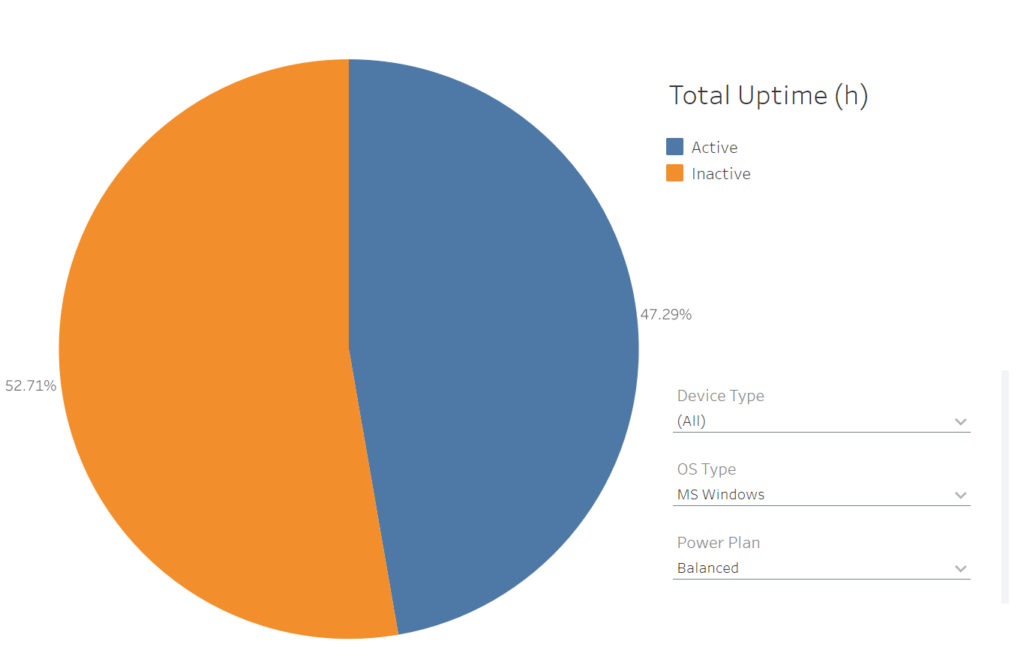
In summary, “Inactive” time closely relates to what would traditionally be perceived as “Idle Time” for these end-user devices. Fine-tuning the device power plans could result in saving kilowatt-hours of electricity by suspending or shutting them down when they are “Inactive.” However, are they genuinely doing nothing?
Collect information with Sentiment Surveys
There may be legitimate cases where long idle times are expected.
Aternity’s Sentiment Surveys are seamlessly integrated into the product, offering an effective way to survey a selective group of users or the entire digital estate from within the product. These surveys help administrators combine survey data with energy efficiency, Sustainable IT data, or performance data collected by Aternity to provide a comprehensive view of which areas of their digital estate need attention. Aternity offers a range of out-of-the-box survey templates, and users can also create their own from scratch.
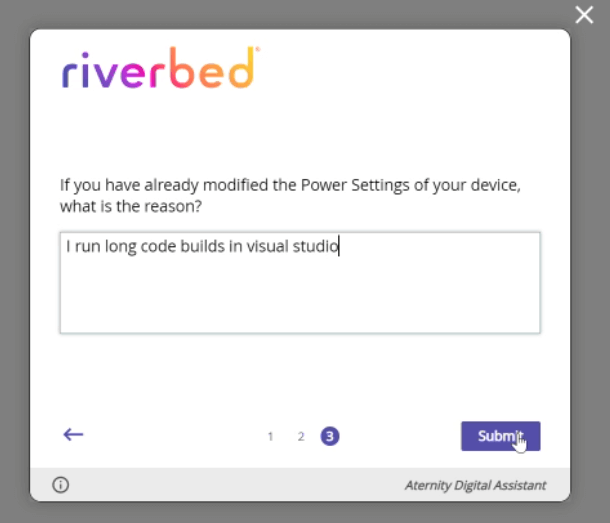
These sentiment survey templates raise awareness, understand employee behavior, and drive cultural change.
Take action with remediation scripts
Once insights are gleaned from Aternity dashboards, Aternity provides remediation scripts and end-user notifications to implement configuration changes, such as updating the Windows registry or customizing a device power plan. Aternity also informs end-users of this activity through notifications. There are various out-of-the-box remediation scripts available, and administrators can create custom scripts from scratch if needed.
Learn more
Riverbed recognizes the growing need for sustainability in IT worldwide. Riverbed Aternity empowers customers to achieve their sustainability goals by offering curated energy-focused dashboards and user-conscious workflows, including automated remediation, to take control of energy expenditure. To learn more about how Riverbed can assist with Sustainable IT, please visit Riverbed’s Sustainable IT page.
